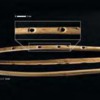The discovery of the world's oldest musical instrument -- a 35,000-year-old
flute made from a wing bone -- highlights a prehistoric moment when the mind
learned to soar on flights of melody and rhythm.
Researchers announced last week in Nature that they had unearthed the flute from
the Ice Age rubbish of cave bear bones, reindeer horn and stone tools discarded
in a cavern called Hohle Fels near Ulm, Germany. No one knows the melodies that
were played in this primordial concert hall, which sheltered the humans who
first settled Europe. The delicate wind instrument, though, offers evidence of
how music pervaded daily life eons before iTunes, satellite radio and Muzak.
The Flutists of the Caves
All told, the researchers have found eight flutes of the same Ice Age vintage
at three different caves in the region. "It is becoming completely clear that
music was a normal part of life then," says archaeologist Nicholas Conard at the
University of Tubingen, who led the research team. "They must have clapped and
danced and sang."
Parrots dance to the beat. Sex-starved mice sing for love, new research shows.
But true music, from rap to Rachmaninoff, is a unique human invention that
resonates in us all, striking neural chords of memory, emotion, motor control,
timing and meaning -- and transforming us in ways that scientists are only
beginning to understand.
Scientists have new evidence that human ancestors were making music 35,000 years
ago with the discovery of what they believe is the world's oldest instrument.
Some of this information comes from The Wall Street Journal, P.A9, and some from the BBC news and other news channels.
Attachments
Original Post






